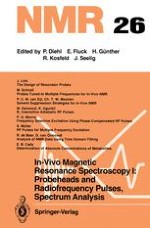1992 | Buch
In-Vivo Magnetic Resonance Spectroscopy I: Probeheads and Radiofrequency Pulses Spectrum Analysis
herausgegeben von: Professor M. Rudin
Verlag: Springer Berlin Heidelberg
Buchreihe : NMR Basic Principles and Progress
Enthalten in: Professional Book Archive
